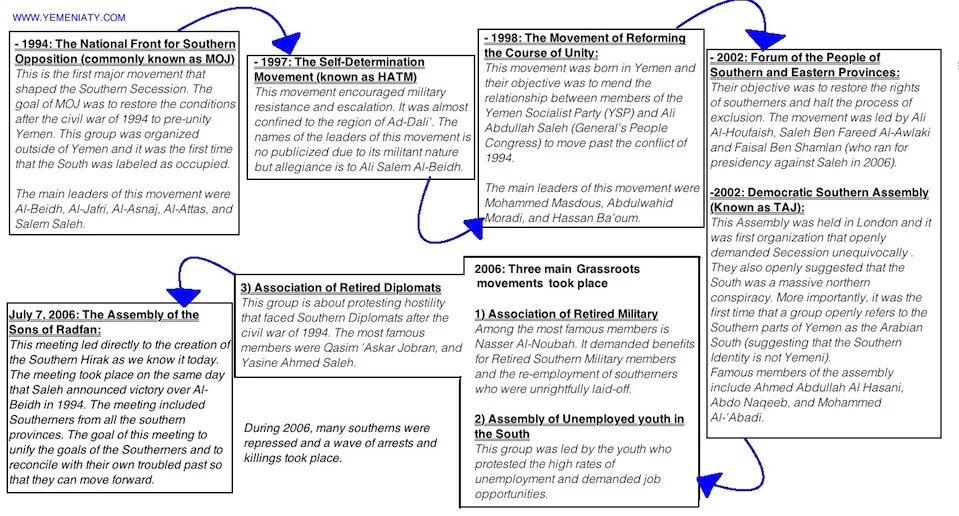Threatened Unity: Understanding the Southern Hirak
Monday, February 25, 2013 (Part 1)
The Southern Movement (Al Hirak Al Janoubi) is frequently explained as a Southern separatist movement that started after Yemen's Civil War of 1994 and reinforced in 2007 when the Assembly of the People of Radfan (Jam'iyat Abna'a Radfan) proposed unifying a number of southern separatist movements to strengthen their unified goal of secession. Today, the Southern Movement is a term that fuses heterogeneous Southern factions by their intent to secede.
The Southern Hirak members believe that they are the victims of a Northern conspiracy since the second half of the 1960s. Although the southern secessioners present their argument as an accumulation of frustrations from the past, in reality, it is a reaction to Yemen's Civil War of 1994. History reveals that many Yemenis, in the North and the South, dreamed about unity prior 1990. Songs from 1977 reveal that Yemenis coveted unity for generations. Song writer Abdulrahman Mouraid wrote;
The ancestors dream, today became certain حلم الجدود اليوم اصبح مؤكد
Unity, Hurray and a thousand welcome بالوحدة ياهلا وألف سهلا
The Southern Movement is nothing but a consequence of a faulty unification. Saleh's implemented unity became the antithesis of the unity that Yemenis longed for; instead of bringing Yemenis together, it segregated them. Since Yemen's revolution of 2011, this movement has gained momentum, however, experts are reluctant to discuss its impact on Yemen's National Dialogue that is set to take place on March 18, 2013.
Taking a Closer Look:
Generally, when we refer to the Southern Hirak, we mean the governorates that belonged to the People's Democratic Republic of Yemen (PDRY). Many of those in the West assume that the Hirak (or demands for secession) is a recent phenomenon in Yemen that intensified with the Arab Spring. Unlike many of the Arab Spring countries, the idea of secession in the South of Yemen couldn't handle four years of unity.
In the diagram below, I trace the most important movements that shaped the Southern Hirak as we know it today.
Southern Hirak 1994-2006
As you see, the demands of the Southerners weren't born in a vacuum. Over time, the demands of these separatists evolved and they eventually claimed that they are "occupied" by the North. They protested the "Yemeni identity" as one that was forced on them.
The year of 2006 was a pivotal year in the Southern Hirak movement. That year, a Southern man named Shamlan ran for presidency against Saleh and lost by a wide margin. Perhaps the Southerners understood that Saleh wasn't planning on changing anything soon. Saleh, being a savvy politician, picked up on that and tactfully made a spectacle of assigning a special committee to investigate the problem of the Southern lands.
After the Civil War of 1994, some elites and officials treated the South as part of their spoils of victory. For example, prime real estate was confiscated and divided amongst them. Only in 2007, a committee made up of six people including notable members Yehya Al-Shuaibi, Saleh Ba'sourah, and Abdul Qadir Hilal concluded that at least 56 officials own illegal properties in the South. Saleh made sure to publicize that the investigation was taking place, but when he received the 500 page report, it was inexplicably disregarded.


